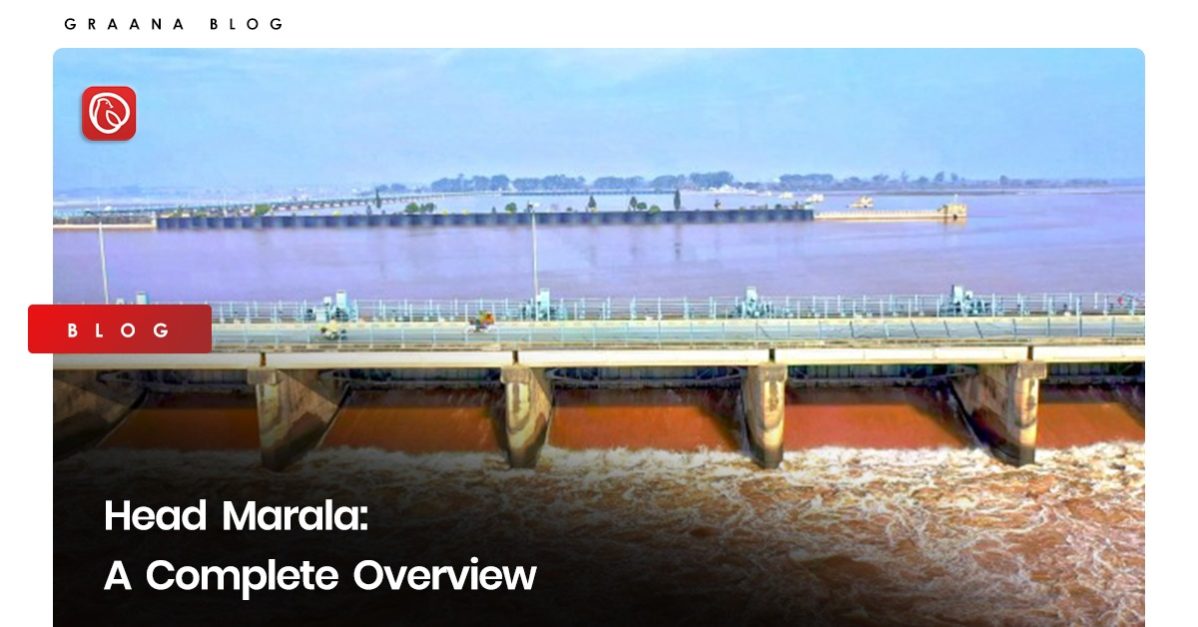
Head Marala is a significant hydro-engineering project on the Chenab River near Sialkot in Punjab. It was built during the British colonial period in India as part of the Triple Canals Project to irrigate vast areas of farmland in Punjab.
The project was aimed to transfer water from the Chenab River to the Upper Chenab Canal, which irrigated over 648,000 acres of farmland in the Gujranwala District, and to the Ravi River, where the Balloki Headworks would irrigate the Montgomery and Multan districts.
The Marala Headworks has undergone many modifications over the years and now serves as a flood control mechanism, water distribution hub, and wildlife sanctuary in Pakistan.
Graana.com features all you need to know about Head Marala and its significance for the country.
The Triple Canals Project, initiated in 1906, was one of the largest irrigation projects in British India, aimed at providing water to arid regions of Punjab. The Upper Chenab Canal was one of the three canals constructed for the project. The canal was opened in 1912 and completed by 1917 at Rs. 37 million.
The Marala Headworks was built as a weir to feed the Upper Chenab Canal. Later, a new Marala Barrage was constructed in 1968 to feed the Marala-Ravi Link Canal and the Upper Chenab Canal.
The Marala-Ravi Link Canal was built between 1952 and 1956 after the Indo-Pakistani water dispute of 1948. The canal was constructed to transfer water from the Chenab River to the Ravi River, which was then fed into the Balloki Headworks. The canal can transfer 623 cumecs of water to Ravi to satisfy the requirements of Balloki and Sulemanki headworks.
The Marala-Ravi Link Canal (MRL canal) is a significant waterway in Pakistani Punjab that serves multiple purposes, including the transfer of water from the Chenab to the Ravi River and the irrigation of about 60,000 hectares of land in the Sialkot and Gujranwala districts.
The canal, constructed in 1956, is approximately 100 kilometres (62 mi) long and has a capacity of 22,000 cubic feet per second (620 m3/s). The canal is an essential water source for agriculture and human consumption in the region.
However, despite its importance, the MRL canal is in disrepair. The canal banks lack fencing, and they have not been repaired since 1954.
The dilapidated condition of the canal banks is a threat to the surrounding communities. In 2014, the banks were breached during floods, causing significant damage to the surrounding areas.
The MRL canal has also played a role in the region’s history. During the Indo-Pakistani War of 1965, Indian forces attempted to reach the MRL canal to drive a wedge between Sialkot and Lahore.
However, the Pakistani troops fought back, resulting in a stalemate. This historic event demonstrates the strategic importance of the canal in the region’s military operations.
Additionally, the MRL canal has been the subject of controversy. During the initial filling of the Baglihar Dam in 2008, the canal was closed, allegedly due to the non-availability of water in the Chenab River. However, Indian commentators dispute this claim, arguing that the canal’s closure was part of a larger political dispute between the two countries.
The Chenab River is a 1,086-kilometer-long river that originates from Chandra Taal in the Lahul & Spiti District of Himachal Pradesh, India. The river is called Chenab after the two tributaries Chandra and Bhaga join at Tandi in Lahul & Spiti district.
It acquires the name Chenab when it enters Jammu and Kashmir, near Kishtwar in India. The river flows through the Pir Panjal Range in India before entering the Sialkot District in Pakistan. The Marala Barrage was built across the river in 1968.
The Marala Headworks is a large-scale hydro-engineering project that controls water flow and prevents floods in the Chenab River which is one of the important rivers in Punjab. The Marala Barrage, built in 1968, has a maximum discharge of 1.1 million ft³/s (31,000 m³/s) and can store 1.7 million acre-feet of water.
Two major water channels originate at the Marala Headworks – the Marala Ravi Link Canal and the Upper Chenab Canal. The Marala Ravi Link Canal is 98 kilometres long and provides water to the Balloki and Sulemanki headworks.
To sum it up, the Head Marala is a significant site in the Sialkot district of Punjab, Pakistan. It is the starting point of the Marala-Ravi Link Canal (MRL canal). The link is a vital regional waterway for multiple purposes, including irrigation and water transfer between the Chenab and Ravi rivers.
The Head Marala also has historical and cultural significance, as it is the site of a famous battle in the Anglo-Sikh War and a revered shrine.
However, the Head Marala faces challenges such as encroachment and water pollution, threatening the area’s ecological and cultural integrity.
For more information, visit Graana blog.
Islamabad: The Shaheen Chowk underpass is expected to be inaugurated next week after nearing completion,…
Dubai’s luxury real estate market has reached a new milestone in 2025, with a prime…
Karachi: Sindh Chief Minister Syed Murad Ali Shah has approved a development package worth PKR…
Islamabad: The Capital Development Authority raised PKR 13.52 billion on the opening day of its…
Riyadh: Saudi Arabia will allow foreigners to own property in the Kingdom starting in 2026…
Islamabad: The federal government is planning to introduce a two-year development roadmap for the capital…